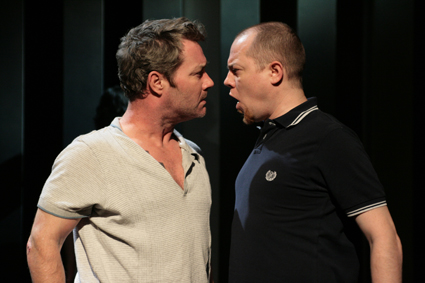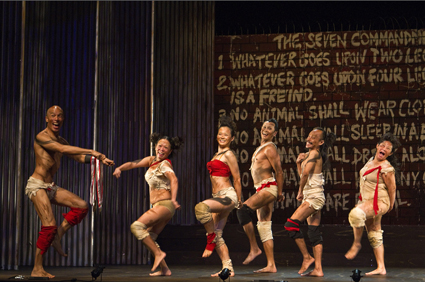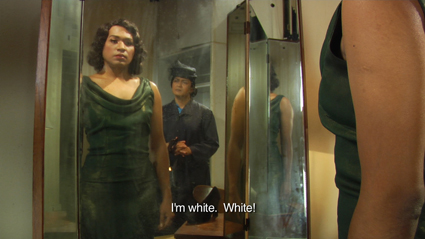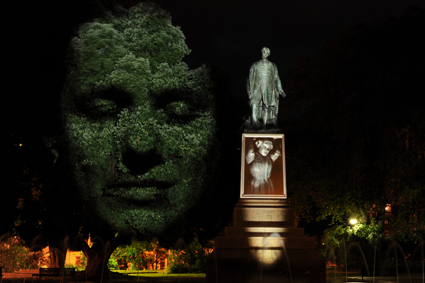singing to survive
judith abell: ten days on the island, tasmania

Martie Maguire, Chris Corrigan, Chronicles of Long Kesh
photo courtesy Ten Days on the Island
Martie Maguire, Chris Corrigan, Chronicles of Long Kesh
A BURLY, RUDDY-FACED INMATE STANDS ATOP HIS BED IN HIS SOLITARY CONFINEMENT CELL AND BELLOWS “I’M THE EMM-CEEEEEE, WITH THE PERSONALITEEEEE.” HE GOES ON TO ENCOURAGE HIS FELLOW INMATES OF CELL BLOCK H TO SING, TELL STORIES, TO DO ANYTHING AS LONG AS THEY JOIN HIM ON ‘AIR’ ON HIS RADIO STATION THAT RELIES ONLY ON THE VOLUME OF ANY ONE VOICE AND THE POROSITY OF A CELL. THIS IS OSCAR. HE IS A MEMBER OF THE IRA AND A LONG-TERM INMATE OF LONG KESH AND HE CAN ALSO MAKE A MOTOWN TUNE SPARKLE.
Chronicles of Long Kesh, one of the headline theatre shows of Tasmania’s Ten Days on the Island festival, depicts a 30-year period in the Belfast gaol that began in the early 70s when the British government had the authority to intern offenders without sentence. We are witnessing a scene that takes place as this group of inmates hovers on the edge of an historic and tragic decision to launch a rolling series of hunger strikes as a protest against their mistreatment in this institution.
Seven players working with a minimal set of grey, body-length boxes perform the high energy play by Belfast local and ex-IRA member Martin Lynch. The show offers insight into the tempestuous politics of the period, but its focus is squarely on all of the people involved—the IRA, the Loyalists, the prison guards and the families of these people. In a post-show talk Lynch says, “I wanted to write a play that was true to the people I grew up with.” In doing so, he pulls no punches when it comes to depicting the violence and despair of these years in gaol, where hunger strikes were preceded by years of protest. During this time inmates remained naked except for blankets, in solitary cells plastered with their own shit as gaol management withdrew services such as cleaning in an attempt to stop the protests.
What is most surprising is that Chronicles of Long Kesh is funny, perhaps even delightful, despite the content remaining so difficult to digest. Lynch’s key device to achieve this mood is song. While the prisoners may not have sung Motown tunes as Lynch’s players do, it is stories of the galvanising action of singing and talking that inspired this play. Lynch recalls that his generating idea was hearing that Bobby Sands—the first to die on the hunger strikes—recalled the story of Spartacus for his fellow inmates over a three-week period.

Animal Farm, Wild Rice
photo Albert Lim
Animal Farm, Wild Rice
Another high energy show with a serious intent, Animal Farm, directed by Ivan Heng of Singaporean theatre company Wild Rice, manages to be a quirky mash-up of the book by George Orwell, while remaining faithful to the detail of the text. Like Lynch’s show, the scene is established by the players rather than the set, with much of the action simply performed in front of a full height ‘brick’ wall painted with the imposed rules of “Animalism.” An enthusiastic one-man band plays from a raised platform within the orchestra pit. Dressed in colours that offer a nod towards communism and revolution—red, white and grey—the players create the various farmyard animals with sets of signature gestures that allow them to flip between duck, goose, pigeon, pig, cow and horse. It takes a little time to get used to each of the characteristics and hear the text of the play through the stamps, snorts and wing flutters, but the players are remarkably consistent and convincing in their portrayals.
While I was able to come to terms with Lynch’s infusion of humour into the traumas of Long Kesh (feeling I was witnessing a true coping mechanism among those inmates), I could never quite relax into Heng’s wacky portrayal of Orwell’s text. With schmaltzy tunes such as “Sugar Sugar” by the Archies, slapstick humour and a generous smattering of pop culture references, the show often felt like a pantomime and yet the serious themes persisted. These opposing directions appeared awkward, although I did muse that I may have seen it with different eyes had I the benefit of a more intimate understanding of the complexities of Singaporean culture.

Ming Wong, still from Life of Imitation
courtesy Ming Wong and Ten Days on the Island
Ming Wong, still from Life of Imitation
Ming Wong: Life of Imitation is a show that offers some insight into an aspect of Singapore’s culture. Installed at CAST gallery, the show presents a small section of a much larger exhibition taken to the 2009 Venice Biennale. It incorporates several works by Ming Wong in conjunction with an array of artifacts such as film posters from a golden age of cinema in Singapore through the 1950s and 1960s. The most compelling of Ming Wong’s works is Life of Imitation in which two projections, each paired with a large mirror, face each other across the gallery. The artist has recreated a short, emotional excerpt from the 1959 film entitled Life of Imitation, where the same two female characters are played by a rotating series of cross-dressed male actors collectively representing the country’s multicultural mix. The dialogue in the looped scene between a young mixed-race woman and her estranged black mother reveals the moment when the daughter is caught out in her assumed ruse as a white woman. Ming Wong’s interpretation of this film hints at an aspiration to escape the constraints of one’s cultural heritage or any defined role. Once again, I sit on the outside of cultural understanding, but I feel as though this work offers a small window into the Singaporean psyche.
In keeping with a core commitment of the festival to be a statewide event, several productions were staged in regional areas. Minotaur—The Island, the first in a trilogy by Chamber Made Opera, was performed in the Dennes Point Community Hall on Bruny Island. With rich mythological fodder as a base, David Young and Margaret Cameron’s work is an esoteric take on the story of Ariadne lamenting her abandonment by Theseus, whom she saved from the Minotaur. Wearing a series of handbags as hats, the players work with a minimal set and makeshift percussion to tell Ariadne’s story. Their focus is on spoken word, noise and movement and on improvised instrumental music rather than sung text.
While I don’t believe that any art form should be constrained in its reach, I felt disappointed that the ‘opera’ seemed to have been lost in the making of Minotaur—The Island. Small moments of poetic, sung text by Deborah Kayser (Ariadne) were haunting and beautiful, but they were fragments in a work that felt more like a series of experiments in physical theatre, held together loosely by the landmarks of a well-known story—a red thread, a labyrinth, an island. I don’t think I’m mistaken in gauging that the audience was at best puzzled at the conclusion. A major factor in my disappointment—particularly given the eight-hour adventure required to get to the island location and back—was that the work was performed in a bland community hall, rather than two minutes away on a beach or jetty within extraordinary surrounds that may have added resonance to the story. Given Chamber Made is known for playing with context in their performances staged in private living rooms, the choice of venue seemed an odd and perhaps risk-averse decision.

Intension 2011, Craig Walsh (three channel video projection at Franklin Square, Hobart
image courtesy and © the artist
Intension 2011, Craig Walsh (three channel video projection at Franklin Square, Hobart
A free festival highlight was Digital Odyssey by Craig Walsh, a public work developed as part of his Hobart residency. Located at Franklin Square and on the edge of the wharf in Sullivan’s Cove, the artworks brought the space of the tree canopy and the water surface to life using projections. The Franklin Square location was the most successful as large video projections of young faces were cast onto the canopy of several trees surrounding the public space. The mapping of light created the illusion that the trees had been trimmed, or had grown into the shape of the faces and I was not alone in finding it mesmerising to stare into the ‘eyes’ of this silent, blinking and seemingly benevolent vegetation.
There is ongoing talk within the local arts community about the festival and its direction. This year’s Ten Days felt like a series of isolated performances rather than a cohesive, transformative event, which is partly to do with the selection of shows but also the unfortunate circumstance of decreased funding. The Ten Days team, to their credit, has continued to battle on in increasingly difficult financial circumstances, but in light of newer festivals in the state such as MONA FOMA, which has quickly become a summer highlight in Hobart as well as Junction Arts Festival in Launceston, it does seem as though a significant rethink is needed. Perhaps we don’t need a statewide festival any more. Perhaps a permanent theme of ‘islands’ is limiting to potential content. And maybe one reason why we all love MONA FOMA so much is that it’s a festival that is not tangled up in defining Tasmania’s identity or battling with the impression of being the poorer cousin to Melbourne or Sydney, yet in the act of ignoring these issues positively contributes to the redefinition of this place.
Chronicles of Long Kesh, writer Martin Lynch, directors Lisa May, Martin Lynch, musical director Paul Boyd, Green Shoot Productions, Hobart Theatre Royal, March 30-April 3; Wild Rice, Animal Farm, director, designer, choreography Ivan Heng, George Orwell’s novel adapted by Ian Wooldridge, composer Philip Tan, Hobart Theatre Royal, March 25-29; Ming Wong Life of Imitation, artist Ming Wong, curator Tang Fu Kuen, Contemporary Art Spaces Tasmania (CAST), March 24-April 24; Chamber Made Opera, Minotaur—The Island, composer David Young, writer, director Margaret Cameron; Digital Odyssey, artist Craig Walsh; Ten Days on the Island, Tasmania, March 25-April 3
RealTime issue #103 June-July 2011 pg. 8






